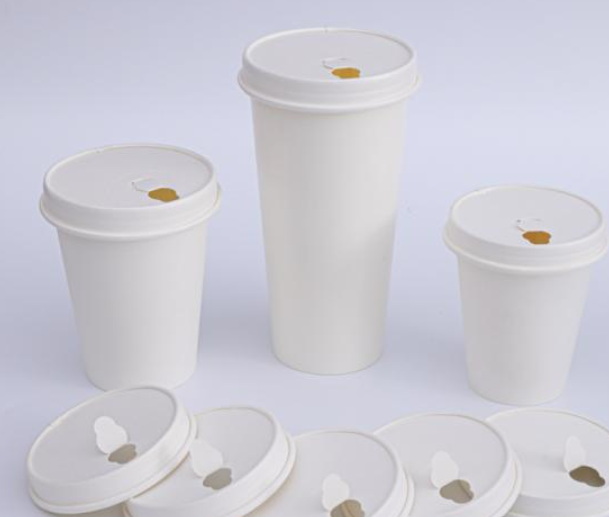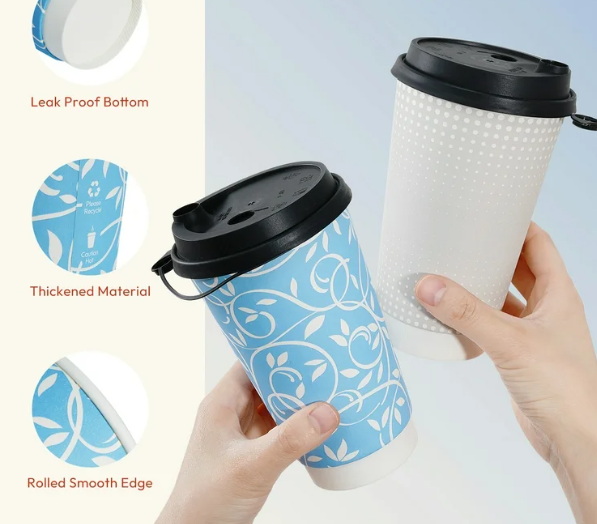
Content Menu
● Introduction to Biodegradable Cups
>> Types of Biodegradable Cups
>> Benefits of Biodegradable Cups
● Secure Lids for Biodegradable Cups
>> Types of Biodegradable Lids
>> Benefits of Biodegradable Lids
● Examples of Biodegradable Disposable Cups with Secure Lids
>> GoodStart Packaging
>> BioPak
>> Takeaway Packaging
● Challenges and Future Developments
>> Future Trends in Eco-Friendly Packaging
>> Consumer Demand and Regulatory Pressures
>> Technological Innovations
● Impact on Businesses and Consumers
● Conclusion
● FAQ
>> 1. What materials are biodegradable cups made from?
>> 2. Are biodegradable cups compostable?
>> 3. How do biodegradable lids compare to traditional plastic lids?
>> 4. Can biodegradable cups be customized?
>> 5. Are biodegradable cups more expensive than traditional cups?
● Citations:
In recent years, the environmental impact of traditional disposable cups has become a significant concern. As consumers increasingly demand eco-friendly alternatives, the market for biodegradable disposable cups with secure lids has grown. This article will explore the options available for biodegradable disposable cups with secure lids, highlighting their benefits, types, and how they contribute to a more sustainable future.

Introduction to Biodegradable Cups
Biodegradable cups are made from materials that can naturally decompose, reducing the environmental harm caused by traditional plastic cups. These cups are often made from plant-based bioplastics like PLA (Polylactic Acid), which is derived from renewable resources such as corn starch or sugarcane[1][7].
Types of Biodegradable Cups
1. PLA Cups: These cups are made from PLA, a bioplastic that is compostable and non-toxic. They are commonly used for both hot and cold beverages and are available with secure lids[1].
2. Paper Cups: These cups are made from paper and often lined with a bioplastic coating to prevent leakage. They are also compostable and can be used with biodegradable lids[2].
3. Bagasse Cups: Made from sugarcane pulp, these cups are biodegradable and compostable. They offer a sustainable alternative to traditional paper cups[1].
4. Bamboo Fiber Cups: Bamboo is a great renewable resource since it grows quickly and uses few resources. Cups made of bamboo fiber are strong and suitable for both hot and cold beverages[1].
5. Cornstarch Cups: Plastics derived entirely from cornstarch are used to make cornstarch cups. They don't work well with hot liquids, so they are mostly used for cold drinks[1].
Benefits of Biodegradable Cups
- Environmental Sustainability: Biodegradable cups reduce plastic waste and can be composted, minimizing landfill contributions[1][5].
- Non-Toxic: Made from natural materials, these cups are safe for consumers and do not leach chemicals into beverages[1][5].
- Customizable: Many biodegradable cups can be customized with branding, making them ideal for businesses looking to enhance their eco-friendly image[1].
Secure Lids for Biodegradable Cups
Secure lids are essential for preventing spills and maintaining beverage temperature. Biodegradable lids are available in various materials, including PLA and sugarcane-based options.
Types of Biodegradable Lids
1. PLA Lids: These lids are made from the same bioplastic as PLA cups and are compostable. They offer a secure fit and are durable[1].
2. Sugarcane Lids: Made from sugarcane pulp, these lids are biodegradable and compostable, providing a sustainable alternative to traditional plastic lids[5].
3. Paper Lids: Some biodegradable cups use paper lids, which are fully recyclable and compostable[6].
Benefits of Biodegradable Lids
- Eco-Friendly: Reduces plastic waste by being compostable.
- Secure Fit: Prevents spills and maintains beverage temperature.
- Customizable: Can be branded to match business logos.
Examples of Biodegradable Disposable Cups with Secure Lids
GoodStart Packaging
GoodStart Packaging offers 100% certified compostable cold cups and lids made from PLA or bamboo paper. These cups are available in various sizes and lid options, providing a premium choice for businesses and consumers.
BioPak
BioPak provides a range of compostable cups, including hot and cold options, with matching lids. Their cups are certified industrially compostable to Australian standards.
Takeaway Packaging
Takeaway Packaging offers biodegradable eco-cups with matching lids. Their cups are made from sustainable materials and are available in various sizes.

Challenges and Future Developments
While biodegradable cups with secure lids offer a sustainable solution, there are challenges to widespread adoption:
- Cost: Biodegradable cups are often more expensive than traditional plastic cups.
- Infrastructure: Composting facilities are not universally available, limiting the potential for biodegradable cups to be composted[5].
Despite these challenges, innovations continue to improve the affordability and accessibility of biodegradable cups. Companies are investing in new materials and technologies to enhance durability and reduce costs.
Future Trends in Eco-Friendly Packaging
In 2025, the packaging industry is expected to see significant advancements in sustainable materials. Bio-based materials, such as plant-based plastics and algae-derived films, will become more prevalent as alternatives to traditional plastics[3][8]. Additionally, localized production will dominate, allowing companies to reduce transit times and lower environmental impact[8].
Consumer Demand and Regulatory Pressures
Consumer awareness of environmental issues is driving demand for eco-friendly packaging. Businesses are responding by adopting sustainable practices and materials to meet consumer expectations and regulatory requirements[3]. Governments are tightening regulations on packaging waste, pushing companies to adopt eco-conscious practices[3].
Technological Innovations
Technological advancements are also playing a crucial role in enhancing sustainability. Smart packaging solutions, such as QR codes that guide consumers on proper disposal methods, are becoming increasingly common[3]. These digital integrations not only improve sustainability efforts but also enhance customer engagement by offering transparency about packaging materials and their environmental impact.
Impact on Businesses and Consumers
Biodegradable disposable cups with secure lids offer numerous benefits for both businesses and consumers:
- Business Benefits: By adopting biodegradable cups, businesses can enhance their eco-friendly image, attract environmentally conscious consumers, and potentially reduce waste disposal costs[1][5].
- Consumer Benefits: Consumers can enjoy their beverages safely, knowing that the cups are non-toxic and environmentally friendly[1][5].
Conclusion
Biodegradable disposable cups with secure lids are a viable alternative to traditional plastic cups, offering a sustainable solution for reducing environmental impact. As technology advances and consumer demand grows, the market for these eco-friendly products will continue to expand. Businesses and consumers alike can contribute to a more sustainable future by adopting these environmentally friendly options.

FAQ
1. What materials are biodegradable cups made from?
Biodegradable cups are typically made from materials such as PLA (Polylactic Acid), paper, or bagasse. These materials are derived from renewable resources like corn starch, sugarcane, or plant fibers[1][7].
2. Are biodegradable cups compostable?
Yes, many biodegradable cups are compostable. They can be broken down in composting facilities or home compost piles, depending on the material and local regulations[1][5].
3. How do biodegradable lids compare to traditional plastic lids?
Biodegradable lids are made from materials like PLA or sugarcane pulp, which are compostable and non-toxic. They offer a secure fit similar to traditional plastic lids but with the added benefit of being environmentally friendly[5].
4. Can biodegradable cups be customized?
Yes, biodegradable cups can be customized with branding or designs. This makes them an attractive option for businesses looking to enhance their eco-friendly image[1].
5. Are biodegradable cups more expensive than traditional cups?
Generally, biodegradable cups are more expensive than traditional plastic cups. However, as demand increases and technology improves, costs are expected to decrease[5].
Citations:
[1] https://gmz.ltd/biodegradable-cups-materials-types-benefits/
[2] https://www.hotpackglobal.com/blogs/the-eco-friendly-revolution-unveiling-the-compostable-nature-of-paper-cups/
[3] https://www.packaging-gateway.com/features/eco-packaging-leads-2025-trends/
[4] https://foodprint.org/blog/environmental-impact-coffee-cup/
[5] https://www.quitplastic.in/post/compostable-and-biodegradable-disposables-eco-friendly-choices-for-a-sustainable-future
[6] https://gmz.ltd/disposable-paper-cups-with-lids/
[7] https://www.keeo.com.au/blogs/news/biodegradable-cups-a-sustainable-sip-into-the-future
[8] https://www.packagingstrategies.com/articles/105306-the-future-of-packaging-bold-predictions-for-2025
[9] https://ecofriendlybeer.com/why-that-compostable-plastic-cup-isnt-so-good-for-the-environment-either/
[10] https://www.canterbury.ac.nz/news-and-events/news/biodegradable-plastic-could-be--material-of-the-future-
[11] https://ecoclicky.com/en/biodegradable-cups-advantages/
[12] http://www.designlife-cycle.com/biodegradable-paper-cups
[13] https://www.hbfuller.com/en/blog/thegluetalkblog/2025/january/flexible-packaging-trends-for-2025
[14] https://www.limepack.eu/blog/paper-cups-en/standard-vs-biodegradable-paper-cups-which-is-better-for-the-environment
[15] https://goecopure.com/future-trends-in-biodegradable-plastic-technology/
[16] https://www.limepack.eu/blog/paper-cups-en/choosing-the-best-sustainable-paper-cups
[17] https://www.yoonpak.com/manufacturing-of-paper-cups/
[18] https://www.packagingdive.com/news/sustainable-packaging-trends-trump-plastics-epr-2025/736764/
[19] https://journals.sagepub.com/doi/full/10.1177/0734242X241279902
[20] https://maadho.com/future-of-disposable-products-key-trends-and-innovations-in-2024

















